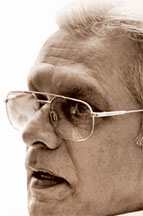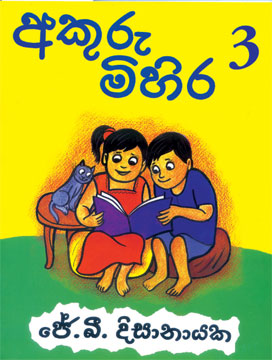Prof. JB launches Sinhala Vade Mecum
Reviewed by Kalakeerthi Edwin Ariyadasa
Every language is a
temple, in which the soul of those who speak it is enshrined. -
Oliver Wendall Holmes
|

Prof. J.B. Disanayaka
|
Prof. J.B. Disanayaka, cherishes the Sinhala language, with a
proprietary ardour. His keen zeal for Sinhala and its ups and downs, is
not at all a learned posturing. It is a deep-sealed fervour and in a
manner of speaking - very much a built-in segment of his inner being.
When I go on in this vein, someone may very well take me up: "How can
you be so downright about his passion for the health of the Sinhala
language?"
I am ready to respond.
Over the years, we have been intimate friends and colleagues. At
public academic and private levels, these close ties have been doubly
strengthened. We have been co-academics, pursuing common scholarly
goals. In many of these contexts, I have experienced the polemical
vigour with which he approaches language-related snarls.
He is disciplined to take any harm done to language as a personal
offence against him - as it were; Highly impressed by this facet of his
personality, I interpreted his two initials "J.B", as standing for Jana
Basa. This interpretation makes it seem, that he inherited the
enthusiasm for language by birth itself.
But, I am straying from my present focus. My primary purpose here is
to produce fresh and stunning evidence, to prove extensively J.B.'s
admirable commitment to the prim and proper use of Sinhala. This "fresh
and stunning" evidence, arrives in the form of a five-part publication
to teach clean and healthy use of Sinhala, to our children.
The series is titled Akuru Mihira (The Delight of Letters) - a phrase
turned out by Sybil Wettasinghe, who possesses a permanent visa to enter
the hearts and minds of children everywhere. The conventional visuals
that occur in our mind, when we talk about "books to teach letters to
children" are of those thin colourful pamphlets which clichetically make
the children utter A for Apple and B for Bat.
 In overwhelming contrast to that kind of simplistic Hodi Potha
(Alphabet Book), J.B's work for the children, is a veritable scholarly
tome, that invariably converts teachers, parents, guardians and the
children themselves into language pundits almost without their knowing
it. In overwhelming contrast to that kind of simplistic Hodi Potha
(Alphabet Book), J.B's work for the children, is a veritable scholarly
tome, that invariably converts teachers, parents, guardians and the
children themselves into language pundits almost without their knowing
it.
This five-part volume is in effect, an epic in juvenile language
training. In the introductory notes to parents and teachers, author
Prof. J.B. Disanayaka elaborates in telling details, the psychological
transformation that is essential, to embed proper language use in the
child-mind.
These instructions are an invaluable guidance to parents and teachers
to imbibe the proper philosophy of teaching language to young ones.
The exercises provided to enlighten the child indicate the author's
profound awareness to bring about language training without unduly
taxing the delicate child-mind. Scholars and educated adults looking at
this series, will invariably be persuaded to appreciate the high quality
of creativity that has been invested in this five-part volume.
The constructive effort J.B. has so assiduously lavished upon this
series, would have sufficed even to bring an epic poem into being. One
could view this work as a highly entertaining anthology of folk
creations.
In his admirable preoccupation with the need to instil the rhythm of
the language into the incipient soul, he has composed thousand of
phrases and lines. All this painstaking endeavour makes me think that
"patience" should be his middle-name. If a child goes through this
series, he will grow up to be an adept in our language culture. He will
resonate to the proper and rhythmic use of language. Such a child will
never stoop to the offence of subjecting language to harsh and wicked
uses.
My considered view of the matter is schools, educational institutes
and homes should have this work as a wider publication. All must have
the access to it. It could even be a secular Sutta - a sermon or a
discourse - out of which adults could recite excerpts for the serene joy
and emotion of all those at home. After Prof. J.B. Disanayaka's Akuru
Mihira, the teaching of Sinhala to our children will never be the same
again. This work will eventually assume leadership in language teaching
books in Sinhala.I am personally delighted and enthusiastic, that a
generation brought up on the language nourishment supplied by Akuru
Mihira, will never offend language by treating it haphazardly and
harshly.
I cannot help but suggest that even university lecturers could do
well to dip into this work surreptitiously and sneakingly at least to
get their alphabet-related nomenclature right.
I must express my gratitude to Sybil Wettasinghe for her linear
sketches, which make J.B's theories dance whimsically, to the utter
delight of the child and perhaps also the adult reader.
|

